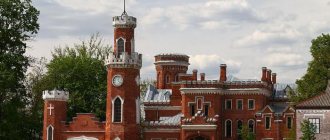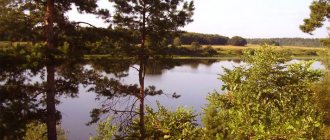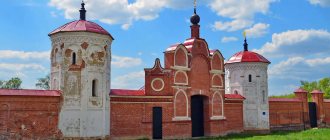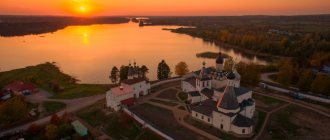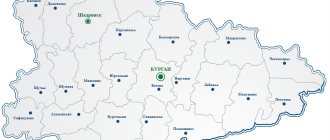Geographical position
In the south of Russia, on the East European Plain and the north of the Caucasus, there is a large subject of the Federation - the Rostov region. Its area is just over 1 million square meters. km, and this is 33rd among all regions of the country. The region borders on the Voronezh and Volgograd regions, Ukraine, Krasnodar and Stavropol territories and Kalmykia. The relief of the region is generally flat: from a slight elevation in the north to a depression in the south. The region is rich in hydro resources. One of the largest rivers in Europe - the Don - and its two tributaries - the Manych and Donets - flow here, there is a large Tsimlyansk reservoir and several lakes. The region is located within the steppe zone; in the south there is a transition to semi-deserts. Most of the territory is occupied by fertile agricultural land, there are few forests, mostly green areas are located in the floodplains of rivers. For many centuries, the life of the population of the Rostov region has been associated with the cultivation of crops and livestock.
Rostov region. Districts
The Rostov region is located in the south of the European part of the Russian Federation, which is under the jurisdiction of the Southern Federal District. In the east it borders with the Volgograd region, with the Voronezh region in the north, in the south of the region with the Stavropol and Krasnodar regions and the Republic of Kalmykia, with the Lugansk and Donetsk regions of Ukraine in the west.
The distance from the region to the capital of Russia, Moscow, is 755 km. One of the largest rivers in Europe, the Don (1,870 kilometers long), flows through the region, on which the Tsimlyansk Reservoir (volume 24 billion m³) is located. The main tributaries of the Don are navigable: the Manych and Seversky Donets rivers. Lakes predominate only 0.4% throughout the region. The southwestern part of the region is washed by the Sea of Azov (in particular, the Taganrog Bay).
Rostov region. Map (The dotted line indicates the boundaries of the area on the map)
According to the State Statistics Committee of Russia for 2012, the population of the region is 4,260,645 people. The population density is 42 people/km2. According to the results of the socio-economic development rating of the Russian Ministry of Economic Development, the Rostov region occupies an honorable 39th place. Compared to 2011, the Rostov region moved up 8 positions.
Districts of the Rostov region and regional centers:
|
|
Administrative-territorial division of the Rostov region Map by district
Cities and towns:
|
|
|
Climate and ecology
The Rostov region is located in a zone of temperate continental steppe climate with mild, short winters and long, hot summers. The region has a lot of sunshine; there are approximately 2,100 hours of such weather per year. The average annual temperature is 10 degrees Celsius. Winter in the region begins in December and lasts until the end of February, the coldest month is January, when the thermometer drops to minus 5 at night. Snow cover does not last long, on average 203 weeks for the entire season. Winter in the Rostov region is wet and windy. Spring begins in the region at the end of February and lasts 2 months; plants begin to bloom already in March; in April the thermometer during the day rises to +15 degrees, sometimes even higher.
The longest season in the region is summer. It starts in May and ends at the end of September. The hottest month is July, when the temperature averages about 25-30 degrees Celsius. Autumn in the region is short and dry, in October and November the temperature drops to 10 degrees Celsius, the sky becomes gloomy more often and the wind blows often. The southeastern territories are distinguished by a more pronounced sharply continental climate and here winters are colder and summers are significantly hotter than in other parts of the region. These climatic features affect the population density of the Rostov region and its distribution. The ecological situation in the region is not much different from the situation in all southern regions of the country. Nature is polluted by cars and people; there are no harmful industries here, but industry has a negative impact on water and air, especially in the Rostov region.
Map of the Rostov region with cities and districts
| 1. Rostov-on-Don | 15. Proletarsk city (Proletarsky district) | 29. Kashary sl. (Kashar district) | 43. Belaya Kalitva city (Belokalitvinsky district) |
| 2. Pokrovskoye village (Neklinovsky district) | 16. Tselina pst (Tselinsky district) | 30. Taganrog | 44. Zernograd city (Zernogradsky district) |
| 3. Chaltyr village. (Myasnikovsky district) | 17. Ust-Donetsk rp (Ust-Donetsk region) | 31. Novoshakhtinsk | 45. Cherished p. (Zavetinsky district) |
| 4. Oblivskaya st. (Oblivsky district) | 18. Tsimlyansk city (Tsimlyansky district) | 32. Mines | 46. Zimovniki pst (Zimovnikovsky district) |
| 5. Quarries rp (Oktyabrsky district) | 19. Chertkovo pst (Chertkovsky district) | 33. Azov city (Azov region) | 47. Kagalnitskaya st. (Kagalnitsky district) |
| 6. Oryol Pst (Oryol District) | 20. Veshenskaya st. (Sholokhovsky district) | 34. Aksai city (Aksai district) | 48. Gluboky rp (Kamensky district) |
| 7. Morozovsk city (Morozovsky district) | 21. Zhirnov rp (Tatsinsky district) | 35. Novocherkassk | 49. Egorlykskaya station. (Egorlyksky district) |
| 8. Millerovo city (Millerovsky district) | 22. Tarasovsky pst (Tarasovsky district) | 36. Kamensk-Shakhtinsky | 50. Dubovskoye village (Dubovsky district) |
| 9. Kuibyshevo village (Kuibyshevsky district) | 23. Rodionovo-Nesvetaiskaya village. (Rodionovo-Nesvetaysky district) | 37. Volgodonsk | 51. Bokovskaya st. (Bokovsky district) |
| 10. Uglerodovsky district (Krasnosulinsky district) | 24. Repair village. (Remontnensky district) | 38. Bataysk city | 52. Sholokhovsky district (Belokalitvinsky district) |
| 11. Bolshaya Martynovka sl. (Martynovsky district) | 25. Salsk city (Salsky district) | 39. Gukovo city | 53. Kazan st. (Verkhnedonsky district) |
| 12. Matveev Kurgan pst (Matveevo-Kurgan district) | 26. Semikarakorsk city (Semikarakorsk district) | 40. Donetsk | 54. Vesely pst (Veselovsky district) |
| 13. Peschanokopskoe village. (Peschanokopsky district) | 27. Soviet Art. (Sovetsky district) | 41. Zverevo city | 55. Romanovskaya st. (Volgodonsk region) |
| 14. Milyutinskaya station (Milyutinsky district) | 28. Krasny Sulin city (Krasnosulinsky district) | 42. Bagaevskaya st. (Bagaevsky district) | 56. Konstantinovsk city (Konstantinovsky district) |
Satellite map of the Rostov region
Switching between the satellite map of the Rostov region and the schematic one is done in the lower left corner of the interactive map.
Rostov region - Wikipedia:
Date of formation of the Rostov region:
September 13, 1937
Population of the Rostov region:
4,181,486 people.
(January 1, 2022) Telephone code of the Rostov region:
863
Area of the Rostov region:
100,800 km²
Vehicle codes of the Rostov region:
61,161, 761
Districts of the Rostov region
Azov • Aksai • Bagaevsky • Belokalitvinsky • Bokovsky • Verkhnedonsky • Veselovsky • Volgodonsk • Dubovsky • Egorlyksky • Zavetinsky • Zernogradsky • Zimovnikovsky • Kagalnitsky • Kamensky • Kasharsky • Konstantinovsky • Krasnosulinsky • Kuibyshevsky • Martynovsky • Matveevo-Kurgansky • Millerovsky • Milyutinsky • Morozovsky • Myasnikovsky • Neklinovsky • Oblivsky • Oktyabrsky • Orlovsky • Peschanokopsky • Proletarsky • Remontnensky • Rodionovo-Nesvetaysky • Salsky • Semikarakorsky • Sovetsky • Tarasovsky • Tatsinsky • Ust-Donetsk • Tselinsky • Tsimlyansky • Chertkovsky • Sholokhovsky.
Cities of the Rostov region - list of cities in alphabetical order
Population of cities in the Rostov region in 2017.
Azov city
— City population: 81,335 people.
Aksai city
- City population: 44828 people.
City of Bataysk
- City population: 124,705 people.
City of Belaya Kalitva
- City population: 40,831 people.
City of Volgodonsk
- City population: 171,471 people.
City of Gukovo
- City population: 66,332 people.
City of Donetsk
- City population: 48,428 people.
City of Zverevo
- City population: 21,126 people.
City of Zernograd
- City population: 24886 people.
City of Kamensk-Shakhtinsky
- City population: 89,657 people.
City of Konstantinovsk
- City population: 17,317 people.
City of Krasny Sulin
- City population: 38,567 people.
City of Millerovo
- City population: 35,540 people.
City of Morozovsk
- City population: 25,467 people.
City of Novocherkassk
- City population: 168,766 people.
City of Novoshakhtinsk
- City population: 108,782 people.
City of Proletarsk
- City population: 19,290 people.
City of Rostov-on-Don
- City population: 1125299 people.
City of Salsk
- City population: 58,179 people.
City of Semikarakorsk
- City population: 22118 people.
Taganrog city
- City population: 250,287 people.
City of Tsimlyansk
- City population: 14463 people.
City of Shakhty
- City population: 235,492 people.
Rostov region
located in the south of Russia in the area of the Don River delta on the coast of the Azov Sea. The Rostov region borders the Volgograd and Voronezh regions, the Krasnodar and Stavropol territories and the Republic of Kalmykia. It also shares a common state border with Ukraine. The Don and several other smaller rivers flow through the region.
The Rostov region is considered the land of the Don Cossacks and the main Russian gateway to the Caucasus. The administrative center is the large port city of Rostov-on-Don, which should not be confused with the ancient city of Rostov, located between Moscow and Yaroslavl. The confusion is compounded by the fact that Rostov-on-Don is usually referred to simply as Rostov, while Rostov is usually called the Great Rostov.
Rostov-on-Don
is closely associated with the Cossacks and is also referred to as the "Gateway to the Caucasus". In 2022, the city served as the venue for the 2022 FIFA World Cup.
A popular tourist destination in the Rostov region is the city of Taganrog
, founded by Peter the Great as a naval base. The most famous landmark of Taganrog is the birthplace of the writer Anton Chekhov, which has now been turned into a museum. Author Mikhail Sholokhov is also associated with the region and the village of Veshenskaya, where the Sholokhov Spring Festival is held annually, dedicated to Sholokhov’s masterpiece “Quiet Flows the Don,” which earned the author the Nobel Prize in Literature.
This port city on the Taganrog Bay of the Sea of Azov can trace its centuries-old history back to the days when it was an ancient Greek outpost mentioned by the historian Herodotus. However, the modern city called Taganrog can be given a specific founding date - September 12, 1698. On this day, Peter the Great issued a decree on the creation of a naval base for the Azov flotilla of the Black Sea Fleet. The port's focus later shifted from a military to a commercial function, especially in terms of exporting Russian grain.
What to see in the Rostov region
To see the main attractions of the region, you should first go to the regional center. There, in the center of the city, the Rostov Cathedral of the Nativity of the Blessed Virgin Mary rises. Another interesting temple is the church of an Armenian monastery, built at the end of the 18th century.
There are also noteworthy historical and architectural monuments in other cities in the region. For example, in Taganrog there is one of the largest historical and architectural reserves in Russia. No less interesting is the nature reserve in Veshenskaya - Sholokhov’s place of residence.
Sights of the Rostov region
Sarkel, Tanais, Old Station, Tchaikovsky House, Alexander Garden, Kobyakovo Settlement, Tachanka, Church of the Intercession of the Blessed Virgin Mary, Matveev Kurgan, Monument to Ermak, Azov Fortress, Provalskaya Steppe, Church of St. George the Victorious, Alexander Column, Donskoy Starocherkassky Monastery, Trinity Church, Aksai customs outpost, Iversky Convent, Church of the Life-Giving Trinity, Church of All Saints, Church of the Nativity, Alekseevsky Gate, Lutheran Church, Church of the Ascension, Church of the Intercession, Postal station of the 19th century.
Population dynamics
Systematic calculations of the population of the Rostov region began in 1959. At that time, just over 3 million people lived here. During Soviet times, the region showed a steady increase in the number of residents, on average several tens of thousands of people per year. In 1997, almost 4.5 million people lived here. But with the advent of change and economic difficulties, the number of residents in the region begins to decline. In 2016 there were 4.2 million people here.
Districts of the region and population distribution
Since 2005, the region has been divided into 12 cities and 43 districts, in which there are 18 urban settlements and 390 villages. Statistics show that the population of the districts of the Rostov region is heterogeneous. The northern and southeastern parts are much less populated than the central territories. The average population density of the region is 42 people per square meter. km. And the highest average population density in the Rostov region is observed in the capital area, here this figure ranges from 2 to 2.5 thousand people per square meter. km. Most of the population is settled in cities (2.9 million people); there is a gradual outflow of rural residents to the cities of the region. The largest cities in the Rostov region in terms of population are the capital of the region (1.1 million people), Taganrog (250 thousand people), Shakhty (236 thousand people), Novocherkassk (170 thousand people), Volgodonsk (170 thousand . people).
Cities of the Rostov region
Rostov-on-Don
— regional center with a population of more than 1.1 million people. A city with a rich history and traditions, has excellent infrastructure. There is a large port, many large industrial enterprises producing agricultural machinery, helicopters, electronics, chemical products, etc. Disadvantages: crime, lack of green space, difficult environmental situation due to air pollution from automobile emissions and industrial discharges into water bodies.
The old part of Rostov-on-Don retains its former appearance
Taganrog
- the second largest city in the region with a population of 254 thousand people. It was founded as a Russian outpost on the shores of the Sea of Azov, as a base for the young fleet. Now it is a sea trade port, a developed industrial city that produces cars, combines, and metallurgical products. In summer, Taganrog turns into a tourist center. Pros: low housing prices, abundance of ancient buildings, small, very calm city. Cons: shallow and blooming sea in summer, outdated public transport system, difficulties finding work.
Cranes of the Taganrog port look confidently into the future
Mines
- the third largest city in the region (237 thousand people). Previously, it was a large coal mining center, but now industrial enterprises are developing here. Among the advantages, one can highlight the developed infrastructure inherited from Soviet times, but there are quite a few disadvantages: unemployment, difficult environmental conditions, street crime.
Volgodonsk
- a city with a population of 170 thousand people, on the shore of the Tsimlyansk Reservoir. There is a lot of greenery and parks, but the environmental situation is quite complex. Moreover, until 2007 it was one of the most polluted cities in Russia. Other disadvantages are the outdated infrastructure, which requires large investments in modernization.
Novocherkassk
- this small (173 thousand people) city is famous for its Cossack traditions. It was founded in 1805 by Ataman Platov, the future hero of the Patriotic War of 1812, precisely as the new capital of the Don Cossacks. It is a very green city where you can find fairly inexpensive accommodation. But there are enough disadvantages. First of all, these are problems with infrastructure - the transport system, healthcare, utilities.
Fountains in Novocherkassk - salvation from the summer heat
Bataysk
- a satellite city of Rostov-on-Don with a population of 115 thousand people. Although it was founded as a workers' village, it is now turning into a residential area of the regional capital, from where people prefer to commute to work in the big city. As a result, Bataysk is quiet, calm, and most importantly, a good environmental situation. Cons: floods are common here, and housing prices are relatively high.
Novoshakhtinsk
- this former city of miners with a population of 110 thousand people has now changed its specialization. After the collapse of the USSR, all mines were closed. As a result, there is now an excellent ecological situation here, and only old waste heaps remind of the mining past. Previously, due to unemployment, the population left the city en masse, which led to extremely low housing prices. Now the situation in the city is gradually changing, new enterprises are being created, and more and more specialists are coming to the city.
Demographic indicators of the Rostov region
As of 2016, the birth rate in the region is growing and amounts to just over 12 newborns for every thousand inhabitants. At the same time, mortality is decreasing, but very slowly and still remains quite high. This causes negative dynamics of natural population growth. And even migration processes cannot offset the problem of the reduction in the number of residents of the region. There is a decrease in the number of people of working age in the region, this is due to low birth rates and increasing life expectancy (71 years). All this increases the demographic burden and negatively affects the economy of the region. In terms of gender, the population of the Rostov region is not much different from other regions; the number of women here prevails over the number of men, especially at older ages.
Economy and employment of the population of the Rostov region
The region ranks 39th in Russia in terms of socio-economic development indicators. The processing, agricultural, coal, heavy and engineering industries are well developed here. The bulk of the population of the Rostov region is employed in the field of wholesale and retail trade - about 20%, in agriculture - 16% and manufacturing - 14%. The largest employers in the region are metallurgical and automobile manufacturing plants in Taganrog, Atommash and Rostselmash, and the Electric Locomotive Plant in Novocherkassk. However, work is not for everyone. The unemployment rate in the region is 5.1%, which is lower than in neighboring southern regions of the Federation, but higher than the national average. In addition, there is so-called unregistered unemployment, and its rates are quite high. Young people cannot find work after graduating from universities, and this negatively affects the demography of the region.
Rostov-on-Don is the region's leader in population
Rostov-on-Don is the capital of the Rostov region, its scientific, educational, financial and industrial center. It is also a major transport hub. This is the only metropolis in the region, which is far ahead of all other settlements. With a population of 1,130,305 people, it ranks 10th in Russia. In terms of agglomeration composition, it is 4th in the country (2,160,000 citizens). Rostov-on-Don is very important in the economic and cultural life of the country. Its unofficial names: Rostov-papa, Gates of the Caucasus, Don capital.
Geographically, Rostov is located on the banks of the large Don River, flowing through the European part of the Russian Federation. It divides the metropolis into two parts. Not far from it are Aksai (135,000 inhabitants) and Bataysk (about 250,000). At the moment, the situation is such that they are almost merging into a single conglomerate. The cities have strong economic and transport connections. The distance between them has been reduced to walking distance. The shortest distance between the buildings of Rostov and Aksay is 34 meters. After the metropolis absorbs its satellites and the legal recognition of this fact, the metropolis will take 3rd place in the country.
Rostov-on-Don was founded as a customs point by imperial decree (1749). The favorable geographical position contributed to the creation of trade routes through Rostov. Its port was important; trade with the Mediterranean countries was carried out from here. The city began to grow rapidly and become richer. In addition to merchants, many people flocked here to work in the port and in factories. Now Rostov-on-Don is one of the richest and economically prosperous settlements located in the south of the country. The largest production facilities in various fields are concentrated here. The most important of them:
- Rostselmash is a well-known manufacturer of grain harvesting equipment. He owns up to 60% of the Russian market;
- "Rostvertol" - an aircraft manufacturer - is the largest cigarette manufacturer in the Russian Federation;
- Gloria Jeans is the largest clothing factory, a federal chain of retail stores;
- TagAZ - automobile - manufacturer, supplier of sunflower oil.
There are many Russian and foreign banks operating in Rostov. Federal retail chains are concentrated here, generating huge trade turnover (Magnit, Sportmaster, Tekhnosila and others). Enterprises provide jobs to the entire population of the metropolis. The unemployment rate here is extremely low. The average salary is higher than in Russia as a whole. Rostov-on-Don has sea and river ports, an international airport, and a network of railways and buses. There are trolleybus, tram and electric train routes. Due to the large number of vehicles, traffic congestion occurs periodically. The city authorities are planning the construction of a metro and a high-speed tram system in order to relieve congestion on transport networks.
